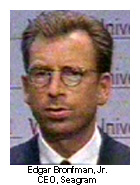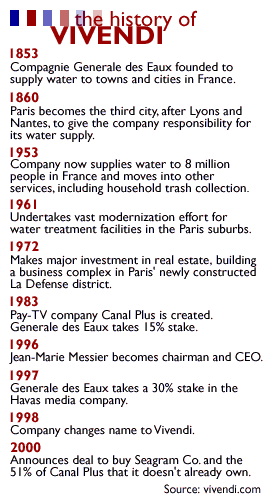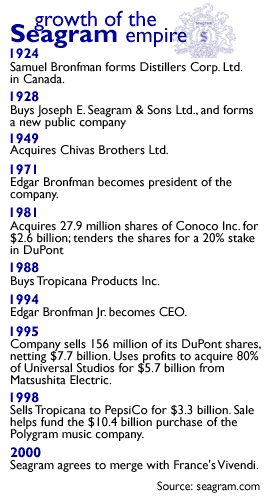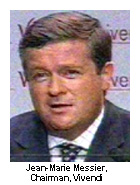|
Vivendi morphs yet again
|
 |
June 20, 2000: 5:53 p.m. ET
The Vivendi-Seagram deal culminates major evolutions in both companies
By Staff Writer Martha Slud
|
NEW YORK (CNNfn) - One company began as a water supplier in the mid-19th century, serving customers throughout its native France and as far away as Venice and Constantinople. The other, a family-run dynasty, got its start as a mail-order liquor distributor during Canada's Prohibition.
Now, Paris-based Vivendi - which over the past 147 years has evolved from water distributor to European communications giant - and Seagram Co. (VO: Research, Estimates), a Montreal media conglomerate with massive movie and music properties in addition to its trademark whiskey and rum, are teaming up in a $34 billion all-stock deal to create a French-Canadian "new media" powerhouse. Vivendi also will buy the 51 percent of European pay-TV operator Canal Plus that it doesn't own.
The companies say Seagram's broad entertainment offerings will get new distribution channels through Vivendi's booming cable and wireless businesses, creating a powerful new entity that can take on the likes of America Online Inc. (AOL: Research, Estimates) and Time Warner Inc. (TWX: Research, Estimates), which are merging to create the world's biggest media firm. (Time Warner is the parent of CNNfn.) The new firm, to  called Vivendi Universal, would be the second biggest media company in the world, with combined annual revenue of roughly $55 billion. called Vivendi Universal, would be the second biggest media company in the world, with combined annual revenue of roughly $55 billion.
The merger creates "a new company for the next generation Internet age," Seagram Chief Executive Edgar Bronfman Jr. said Tuesday at a news conference in New York announcing the deal.
Bronfman will become vice chairman of the new company and head all of its music and Internet properties. The company's venerable wine and spirits business, meanwhile, likely will be sold.
"It is in some senses a bittersweet day. It is a transformation of the company from what it was to an entirely new world," said Bronfman, the third in a line of Bronfmans to run the company. "But it is my job, as it always has been the job of the Bronfman family, to protect and to promote the interests of all shareholders. And we believe firmly that in making this transaction and in creating this company, our shareholders will be vastly rewarded."
A growing telecom firm
For both companies, the merger marks a startling shift from their corporate beginnings.
Vivendi, originally known as Compagnie Generale des Eaux, was founded in  1853 in Paris by a group of investors that included the illustrious Rothschild family. The company supplied water to the French cities Lyons, Nantes and Paris, and later Venice, Italy, and Constantinople (now Istanbul, Turkey). 1853 in Paris by a group of investors that included the illustrious Rothschild family. The company supplied water to the French cities Lyons, Nantes and Paris, and later Venice, Italy, and Constantinople (now Istanbul, Turkey).
A century later, the company expanded to other services, such as trash collection, as well as investing in energy and real estate. Generale des Eaux broadened its holdings to include communications in the 1980s, taking a 15 percent stake in Canal Plus in 1983. (CNN International operates a joint venture with Canal Plus in Spain.)
While it continued to expand its water services business, the company also pursued more acquisitions on the communications side, increasing its stake in the Havas media company and launching a mobile telecom provider, Cegetel. In 1998, the company shed the cumbersome Generale des Eaux name, choosing the new moniker Vivendi, which it said represented "vivacity and mobility."
The company is headed by Jean-Marie Messier, a former Lazard Freres investment banker who took the helm in 1996. He will become chief executive of the new Vivendi Universal.
Built by the Bronfmans
Seagram dates back to 1916, when family patriarch Samuel Bronfman bought the Bonaventure Liquor Store Co. in Montreal and started to sell liquor by mail - the only way to legally supply alcohol during Canadian Prohibition days.
In 1924, Bronfman opened the Distillers Corp. Ltd. Four years later, he  bought the larger Joseph E. Seagram & Sons and created a public company. bought the larger Joseph E. Seagram & Sons and created a public company.
The company built itself into a massive spirits and wine business, forming the Captain Morgan rum company and acquiring the Chivas Brothers Ltd. scotch whiskey business. Burnishing its image, the company commissioned the famed architect Ludwig Mies van der Rohe in the 1950s to build the landmark Seagram building on Manhattan's Park Avenue.
For Seagram, perhaps the most significant event in its history was the appointment of Edgar Bronfman Jr. as chief executive in 1994, who took over from his father. The younger Bronfman, who briefly tried his hand at moviemaking by producing the Jack Nicholson film "The Border" in the early 1980s, was instrumental in encouraging the company to shift into media and entertainment.
Many critics, however, write off Bronfman as a starstruck lightweight who has made a series of missteps for the company because of his attraction to Hollywood glamour. In 1995, Seagram sold 156 million shares of DuPont that it had acquired 14 years earlier for $7.7 billion, using the profit to buy Universal Studios for $5.7 billion. Three years later, the company paid $10.4 billion to buy the Polygram NV music company, making Seagram the biggest music company in the world.
 Now that Seagram and Vivendi's paths have crossed, Vivendi becomes the latest steward of Universal, which has had a tumultuous ownership history. Now that Seagram and Vivendi's paths have crossed, Vivendi becomes the latest steward of Universal, which has had a tumultuous ownership history.
The company, once known as MCA Inc., was sold to Japan's Matsushita Electric in 1990. But the combination of Matsushita's low-cost electronics and MCA's entertainment assets proved not to be a good fit. Five years later, Matsushita sold out to Seagram for a bargain-basement price of $5.7 billion. Bronfman immediately launched a refurbishment program, hiring scores of consultants to examine every facet of the company's operations and find ways to cut costs and improve Universal's film studio.
But under Seagram, the division has had its woes, struggling with a series of box-office flops and disappointing profit. The new owners of Universal will have to overcome the studio's troubled record, analysts say.
 "No one's been able to make it too economically worthwhile yet," Linda Varoli, a deals analyst at Merger Insight, said of Universal. "I guess the question is, 'Is Vivendi going to get caught in the same thing that everyone else has, of how you make this business profitable?'" "No one's been able to make it too economically worthwhile yet," Linda Varoli, a deals analyst at Merger Insight, said of Universal. "I guess the question is, 'Is Vivendi going to get caught in the same thing that everyone else has, of how you make this business profitable?'"
Meanwhile, the companies are uniting under a common interest - the need for distribution, said David Londoner, a media analyst at ABN Amro in New York.
"Any time that you put content ownership and distribution of that content together, you enhance the value of the content," he said. "It pays to control your own distribution -- and this is the same thing that's going on with AOL/Time Warner ... it makes sense."
The new company combines global assets - something particularly important for Vivendi, which is not well-known outside Europe, said Alan Gould, media analyst at Gerard Klauer Mattison.
"Seagram's is bringing the content, and Vivendi is bringing the distribution, and it brings the global scale that one needs in an environment competing against an AOL/Time Warner, Viacom/CBS, some of the major companies in the worldwide industry," he said. "This gives Vivendi a global distribution platform."
There are questions, however, of how Seagram - with its culture of family ownership - and the Vivendi conglomerate will work together. Varoli, of Merger Insight, said she expects Bronfman to continue to play a major role in the new company involving all things Hollywood.
"I would imagine they would let him run that end," she said. "I don't think they'll be as interested in running the day-to-day operations than in having access to the content that comes out of it." 
|
|
|
|
|
|
Vivendi
Seagram
|
Note: Pages will open in a new browser window
External sites are not endorsed by CNNmoney
|
|
|
|
 |

|

